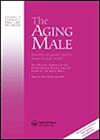Usefulness of routine assessment of free testosterone for the diagnosis of functional male hypogonadism
IF 2.7
4区 医学
Q3 ENDOCRINOLOGY & METABOLISM
引用次数: 2
Abstract
Abstract Objective To investigate whether routine assessment of free testosterone improves the diagnostic accuracy of functional hypogonadism. Methods Total and free testosterone (calculated on SHBG levels) were determined in 188 patients with sexual symptoms and 184 with infertility. Results Hypogonadism (calculated free testosterone <63 pg/ml) was found in 47/188 (25.0%) patients with sexual symptoms and in 21/184 (11.4%) with infertility. Total testosterone determination misdiagnosed hypogonadism in 8.4% (12/143) of men with sexual symptoms and in 2% (3/152) with infertility. In subjects with borderline total testosterone, only 24.7% (19/77) had hypogonadism confirmed by free testosterone levels. Free testosterone levels significantly correlated with age, haematocrit, gonadotropins, gynecomastia, BMI, and number of co-morbidities, whereas total testosterone associated only with the latter two. Furthermore, age, haematocrit, BMI, and the presence of erectile dysfunction and of low libido were significantly different between men with normal and low free testosterone, whereas only BMI and low libido were significantly different between patients with normal and low total testosterone. Conclusion Routine assessment of free testosterone allows a more accurate diagnosis of functional hypogonadism, especially in men with sexual symptoms. Free testosterone levels associate with clinical and biochemical parameters of androgen deficiency better than total testosterone levels.游离睾酮常规检测对功能性男性性腺功能减退的诊断价值
摘要目的探讨游离睾酮的常规评估是否能提高功能性性腺功能减退症的诊断准确性。方法测定188例性症状患者和184例不孕患者的总睾酮和游离睾酮水平。结果性腺功能减退(计算的游离睾酮<63 pg/ml)在性症状患者中为47/188(25.0%),在不孕患者中为21/184(11.4%)。8.4%(12/143)有性症状的男性和2%(3/152)有不孕的男性中,总睾酮测定被误诊为性腺功能减退症。在总睾酮处于临界水平的受试者中,只有24.7%(19/77)的人患有经游离睾酮水平证实的性腺功能减退症。游离睾酮水平与年龄、红细胞压积、促性腺激素、女性乳房发育症、BMI和合并症数量显著相关,而总睾酮仅与后两者相关。此外,年龄、红细胞压积、BMI以及勃起功能障碍和性欲低下的存在在游离睾酮正常和低的男性之间存在显著差异,而只有BMI和性欲低下在总睾酮正常和较低的患者之间存在显著不同。结论常规检测游离睾酮可更准确地诊断功能性性腺功能减退症,尤其是有性症状的男性。游离睾酮水平与雄激素缺乏症的临床和生化参数的相关性好于总睾酮水平。
本文章由计算机程序翻译,如有差异,请以英文原文为准。
求助全文
约1分钟内获得全文
求助全文
来源期刊

Aging Male
医学-泌尿学与肾脏学
CiteScore
6.40
自引率
3.80%
发文量
33
审稿时长
>12 weeks
期刊介绍:
The Aging Male , the official journal of the International Society for the Study of the Aging Male, is a multidisciplinary publication covering all aspects of male health throughout the aging process. The Journal is a well-recognized and respected resource for anyone interested in keeping up to date with developments in this field. It is published quarterly in one volume per year.
The Journal publishes original peer-reviewed research papers as well as review papers and other appropriate educational material that provide researchers with an integrated perspective on this new, emerging specialty. Areas of interest include, but are not limited to:
Diagnosis and treatment of late-onset hypogonadism
Metabolic syndrome and related conditions
Treatment of erectile dysfunction and related disorders
Prostate cancer and benign prostate hyperplasia.
 求助内容:
求助内容: 应助结果提醒方式:
应助结果提醒方式:


